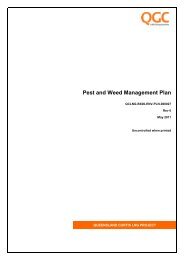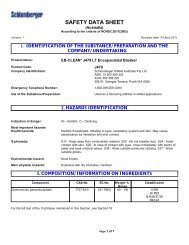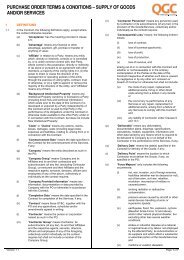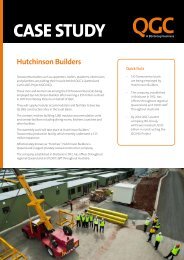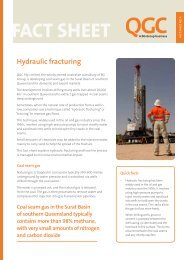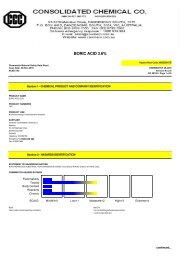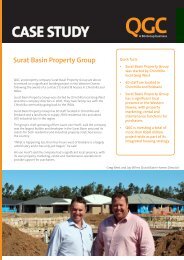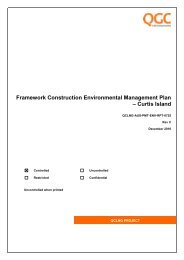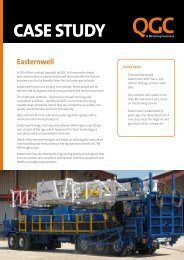The Energy July 2012, Issue 24 - QGC
The Energy July 2012, Issue 24 - QGC
The Energy July 2012, Issue 24 - QGC
- No tags were found...
Create successful ePaper yourself
Turn your PDF publications into a flip-book with our unique Google optimized e-Paper software.
<strong>July</strong> <strong>2012</strong> <strong>Issue</strong> <strong>24</strong>Crossing the CondaminePipeline goes under the riverA new source of waterHigh quality water from the gas industry for farmers aroundChinchillaLife on a drill rigObservations from the fieldPLUS...QCLNG spend nears A$8 billionRig safety training stepped upBetter facilities for children with disabilities in Biloela
Dear colleagues,One of the great strengths of <strong>QGC</strong> is the diversity of our people. We have come fromall over Australia and around the world, bringing our expertise to build the world’s firstCSG-to-LNG project.We all have different roles to play but each of us has many responsibilities in common.<strong>The</strong> most important of these is, of course, safety. However, another very important oneis to know about the benefits our project and our industry are bringing to the lives ofQueenslanders so that we can answer questions from friends, family and interested parties.Basically, each one of us is an ambassador for <strong>QGC</strong> and the CSG industry.You can read about many of these benefits, and get up to speed on advances in ourbusiness, in this issue of <strong>The</strong> <strong>Energy</strong>.So next time someone asks what we’re bringing to the community, you might mentionone or two of the following facts.Our recent six-monthly report to the Queensland Coordinator-General on Australianindustry participation noted that <strong>QGC</strong> is delivering significant benefits across the QCLNGProject area.We have awarded more than A$1 billion worth of contracts in the Gladstone region andnearly A$400 million in the Western Downs region between Toowoomba and Roma.Of the A$8 billion we have spent since the start of 2010 developing QCLNG and our domesticgas business, 74% has been spent in Australia and 59% in Queensland.At the end of March, Queensland and Australian companies were engaged on contractswith us valued at A$6.1 billion for a wide range of goods and services.Our total work force has now passed 7300, with about 1600 staff and contractors workingdirectly for <strong>QGC</strong> and more than 5700 engaged by our major contractors.Our industry body APPEA, in describing the huge and beneficial impact oil and gas projectsare having on the Australian economy, noted recently that the cost of the iconic SnowyMountains Scheme in today’s money would be about A$8 billion.Compare that with our own A$20.4 billion project and you begin to get a sense of thescale of our work.Whenever you have a tough day, keep this in mind: we are helping the communities wherewe live and work, and through our employment and numerous local contracts are helpingthousands to pay their bills, send their children to school and put food on their table.What’s more, they may even have cooked that food with energy from gas supplied by <strong>QGC</strong>.Derek FisherBenefits for allManaging Director<strong>QGC</strong>Page 1 NEWS JULY <strong>2012</strong>
NewsProject update: QCLNG progress 3A Bird’s eye view of QCLNG 5Crossing the Condamine 7Minister inspects pipeline 8A new source of water 9Rig safety training stepped up 10Understanding upstream 11QCLNG Project spend nears A$8 billion 12Life on a drill rig 13Key plant components en route to Australia 14CommunityBetter facilities for children with disabilities in Biloela 15Funds continue to flow for communities 15First-hand engineering experience for students 16Making a difference in Dalby 17Good response to Good Sports program 17USQ nursing students complete placements 18Supporting marine activities in Port Curtis 19Community engagement in Gladstone 19Information session for Gladstone boaties 19Happy home for <strong>QGC</strong> chairs 20Mt Larcom Show 20Staff NewsLowndes gets OAM for safety work 21<strong>QGC</strong>’s bay city rollers 22Raising money to combat breast cancer 22On the coverAerial view of the LNGplant construction siteon Curtis IslandNEWS JULY <strong>2012</strong>Page 2
Project update:QCLNG progressLNG plant• On Curtis Island the largest single concrete pourto date has been completed with more than1,800 cubic metres of concrete laid for majorequipment foundations.• In another important milestone, temporarypotable water storage tanks and a distributionsystem have been commissioned.• <strong>The</strong> water is drawn from the mainland viaa common user pipeline that was recently laidacross Gladstone Harbour.• <strong>The</strong> water will supply QCLNG’s Curtis Islandworkers’ village and will also be used to makeconcrete for plant facilities, including the steadilyclimbing 140,000 cubic metre LNG storage tanks.• <strong>The</strong> number of workers able to be accommodatedon the island continues to rise and now stands atnearly 700.• By mid-June, construction crews had worked fivemillion hours on the LNG plant, with about threemillion hours accrued in Gladstone, 1.9 million inthe Thailand construction yard and the remainderby <strong>QGC</strong>.• <strong>The</strong> total LNG plant work force is about 3,600 andis rapidly growing.Gas fields• Much of the activity in the gas fields is centredon construction at field compression stations.• Bulk earthworks, piling and main foundation worksare under way at three new field compressionstations including David, Isabella and Ruby,as well as at the Ruby central processing plant.• In other key achievements the Northern Fly Camphas been completed with 199 rooms operating.• A further water storage pond, Jen 2, has also beencompleted in the south near Dalby.• A twice-weekly dedicated train service to transportsteel trunkline pipe from Brisbane to Mileshas started.• About 80 trips are planned over the nexteight months.• Already, half of the gas trunkline pipe receivedin the first vessel at Brisbane has been railed tothe Miles Supply Base.Pipeline• A key milestone for the quarter was completionof automatic spread welding on the 196km gascollection header.• Another important achievement was successfulinstallation of 685m of 42” diameter pipeline byhorizontal directional drilling under the CondamineRiver, south-west of Chinchilla.• Civil work continues at the gas collection headerreceipt station with concrete footings now pouredand structural steel erection under way.• Construction of the Targinie Creek Bridge at <strong>The</strong>Narrows is nearing completion and the rail lineis progressing.• On Curtis Island, clearing and mulching up to theLNG plant boundary is finished, pipe delivery iscontinuing and pipe stringing along the right ofway has started.
<strong>The</strong> Windmill Road Camp in ChinchillaA BIRD’S EYE VIEWof QCLNG<strong>The</strong> two LNG storage tanks quicklytaking shape on Curtis Island
<strong>The</strong> Construction Camp on Curtis Island<strong>The</strong> Materials Offloading Facility on Curtis IslandTarginie Creek Bridge construction at <strong>The</strong> Narrows<strong>The</strong> Zeller Street Camp in Chinchilla
Crossing theCondamineConstruction of the 540kmburied natural gas pipelinenetwork to take gas fromthe Surat Basin to the LNGplant on Curtis Island involvescrossing many obstacles, fromroads to the Condamine River.Such crossings requiredetailed planning and carefulexecution in a way best suitedto the terrain.In the case of the CondamineRiver, <strong>QGC</strong> chose whatis known as horizontaldirectional drilling to enablethe pipeline to be laid underthe river.Horizontal directional drillingavoids the need for an opentrench and, when the sub-soilconditions are suitable, is usedto minimise environmentalimpact.<strong>The</strong> technique is generallyused under rivers and creeks,highways, and other pipelines.At the Condamine, the685m crossing was designedto avoid disturbance ofthe river bed and is theonly such crossing for thepipeline.<strong>QGC</strong> chose horizontaldirectional drilling for theriver because of its width anddepth, the river’s constantflow, and the substantial treesand plants on the river banks.<strong>The</strong> alternative techniquewould have been an opencuttrench.Horizontal directionaldrilling involves extensivegeotechnical work toascertain soil conditionsat various levels and stresschecks on the pipe duringinstallation and operation.In the first stage of directionaldrilling, a 12” horizontal pilothole is drilled under theriver with external surfacemounteddetectors to checkthe exact position of thedrilling bit to ensure it isheading in the right direction.After the pilot hole has beendrilled, reaming tools openthe hole to 56" so the 42" pipecan be threaded through.During drilling, mud is usedto maintain stability in thehole and to prevent it fromcollapsing.<strong>The</strong> mud also lubricates thedrill bit and removes debris,called tailings.When the horizontal hole hasbeen completed, the pipelineis pulled through it from theopposite river bank.<strong>The</strong> whole pipeline ismounted on rollers toensure a smooth, continuousoperation over about threehours, a significant contrastto the 10 to 12 weeks neededto prepare and drill the hole.Crossing of the CondamineRiver was completed safelyand successfully.<strong>The</strong> only evidence of a pipelinecrossing at this locationwill be marker posts.General view of 42" pipeline section on rollersView of the pipeline string to the entrance hole drilled under the Condamine RiverFinal checks before starting to pull the pipePage 7 NEWS JULY <strong>2012</strong>
Natural Resourcesand Mines Ministerinspects pipeline42" pipeline on rollers, ready to be pulled through the holeDetail of the reamer attached to the pipe string, before the “pull through”Queensland’s Minister for Natural Resources and Mines, Andrew Cripps,(second from left) recently visited part of the 540km QCLNG pipeline nearMiles with officials from his department and the Queensland ResourcesCouncil. <strong>The</strong> Minister was impressed with progress of this part of theproject and congratulated the pipeline crews on a job well doneAll ready to start pulling the pipeDid you know?It will take about 32hours for a moleculeof gas to make itsway from <strong>QGC</strong>’ssouthern gas fieldsto the LNG planton Curtis Island.NEWS JULY <strong>2012</strong>Page 8
Dougal Hains at the water treatmentplant at Kenya, which is supplying upto eight megalitres of water a day foruse by local landholdersA NEW SOURCEof water…Some farmers aroundChinchilla are getting a firsttaste of what’s to come –high quality water from thegas industry.In coming months, up toeight megalitres a day from<strong>QGC</strong>’s water treatment plantat <strong>QGC</strong>’s Kenya productionsite, is expected to startflowing down a pipe-linetowards Chinchilla Weir.Woleebee Creek, south-westof Wandoan, taking <strong>QGC</strong>’sprocessed water productionclose to 200 megalitres aday by the middle of 2014.“This is a real bonus forfarmers with access to thisadditional water,” saysDougal Hains, who is focusedon successful delivery ofwater infrastructure forUpstream Projects.from the Kenya plant willbe channelled into a 23kmpipeline to the ChinchillaWeir.SunWater built and nowowns and operates thepipeline, and has agreementswith farmers to take thewater from the pipeline andwithin an irrigation schemestretching 75km along theCondamine River.recognise the significanceof the new water source, itssize and potential benefits– and the engineering andconstruction achievementthe water treatment projectsrepresent.“<strong>The</strong>se two treatment plantswill be turning out up to 185megalitres of high qualitywater each and every day,”he said.When the Kenya WaterTreatment Plant is fullyoperating in 2013, it willprovide up to 95 megalitresa day for use by farmers,industry and the community.A similar size water treatmentplant is proposed at“<strong>The</strong>ir farms will be almostclimate-proof with respectto water supply for atleast the next decade,and probably longer.”Under a deal with waterdistributor SunWater, treatedwater from coal seamsSunWater is investigatinga similar scheme with a120km pipeline from <strong>QGC</strong>’sproposed Woleebee Creekwater treatment plant toGlebe Weir, north of Taroom.Dougal says the widercommunity is starting to“<strong>The</strong>y can invest in theirproperties knowing thata supply of the mostessential commodity –water – is secure.”Dougal HainsPage 9 NEWS JULY <strong>2012</strong>
“That’s the equivalent ofthe average daily waterconsumption of Brisbane or10 times that of Toowoomba(based on an average dailyconsumption of 150 litres aperson a day).“It’s a lot of water in a regionof Queensland that has ahistory of cyclical droughts.“And, while some farmers willprobably be able to droughtprooftheir properties, thewhole community andenvironment will benefitbecause a significant numberof farmers will be less relianton water from other sources,especially in dry seasons.”Having watched progressof the Kenya plant from theground up, Dougal is acutelyaware of its engineeringsignificance and complexity.He believes the project isa world-first, with all fourwater treatment processes inone package: ultra filtrationof raw coal seam water; ionexchange to remove mineralsfrom the water; reverseosmosis to desalinate it;and brine concentration torecover almost all remainingwater for reuse.<strong>The</strong> plant will also boast a25 megawatt power station.On top of that, <strong>QGC</strong>’s watertreatment plants at Kenyaand Woleebee will be biggerthan anything planned byother liquefied natural gasproponents in Queensland.“This is a massive commitmentin terms of scale andfunding,” Dougal said.“We’re investing about A$1billion on treating water andmaking it available to thecommunity. It’s a genuine‘good news’ story.”Dougal said the successfulprocess proving of a smaller12 megalitre-a-day sectionof the Kenya plant hadprovided confidence thatthe main plant would meet– and possibly exceed –performance expectations.<strong>The</strong> smaller plant had alreadybeaten production targets byabout 30% while deliveringquality water with no safetyor environmental issues.Dougal said the Kenya plantwas expected to recoverabout 97% of the water itprocessed, leaving only asmall concentrated saltstream that would be storedin reinforced double-linedponds until a commercial usefor the salt was determined,most likely later this year.Rig safety trainingstepped up<strong>QGC</strong> has launched a newsafety training programaimed at avoiding injuriescaused by slips, trips and fallsat work, particularly arounddrilling sites.Called SureFoot, the programmakes people aware ofhazards when walking aroundrigs, and how to eliminate,mitigate or avoid them.SureFoot is being rolled outto all <strong>QGC</strong> well engineeringcontractors.<strong>The</strong> first session, at anEasternwell drilling rig nearChinchilla, was attended byabout 20 workers who weregiven an understanding of thepotential hazards of walkingaround rigs and then putthrough two exercises ona walking path set up withhazards that can be expectedon rig sites.One exercise involves teamsof two carrying an objectthrough the hazardouswalkway. Each worker is askedto discuss one of the hazards,its potential impact on peopleand the rig operation, andhow best to eliminate ormitigate the hazard.<strong>QGC</strong> Well Engineering HSSEManager Wayne Porteous,who developed the SureFootprogram, said the response tothe training had been positive.“Rig workers recognise thataccidents are possible evenwhen they are doing verysimple tasks, such as walking,”Wayne said.“Since the start of <strong>2012</strong>, about40% of incidents recordedby <strong>QGC</strong> Well Engineeringthat resulted in injury werea direct result of slips, tripsand falls due to the personnot recognising hazardsin the walking space andtaking the necessary actionto mitigate or eliminatethe hazards.”Workers completing theSureFoot program receivea certificate.When all drilling crews havebeen trained, the SureFoottrailer and training propswill be stationed at theWell Engineering trainingpad at <strong>QGC</strong>’s Windibriprodution site, south-westof Chinchilla, and will be partof compulsory training forall new rig workers.<strong>The</strong> Kenya Water Treatment PlantRig crew members are put through their paces by the SureFoot programNEWS JULY <strong>2012</strong>Page 10
<strong>The</strong> Bellevue Field Compression StationUNDERSTANDINGupstream<strong>The</strong> gas industry landscapeon the Western Downs haschanged dramatically in thepast two years.And change is still happening,but now even faster.One of <strong>QGC</strong>’s best witnessesto this is Larry Buckeridge.Larry has been involved withmost upstream gas fieldsdevelopment since mid-2010, including constructionof compression stations,sub-stations, trunklines,pumping stations, well heads,gathering networks, pondsand all the different kinds ofinfrastructure and peripheralworks that go with them.“It’s been interesting, andwe’ve learned a lot alongthe way,” he said.“My group’s been thepathfinders, in a way.“We’re had a lot of help fromthe environment team, andthe regulators, generally,have been supportive.“It’s been a learning exercisefor them as well.”Larry believes that <strong>QGC</strong> hasmade outstanding progresssince the QCLNG Projectwas sanctioned though heis aware of the “knockers”who have criticised progress,problems and delays alongthe way.“People like to say we are latedelivering, but they quietendown a bit when we pointout that we’re the only oneswho have delivered anythingso far,” he says.Larry believes that one ofthe most important lessonsLarry Buckeridge at the Argyle Field Compression Stationfor companies developinggas fields is to make surethey explain exactly what’shappening, why and whatthe impacts will be.He believes this is something<strong>QGC</strong> is getting better at allthe time but that a sustained,Page 11 NEWS JULY <strong>2012</strong>
long-term effort is required.Project proponents andthe gas industry had tocontinually improve onhow they explain things,and how they answerunfounded criticisms andmisinformation.“Gas well integrity is a goodexample,” he said.“Even now, people don’tunderstand that modernwells are doubled-sleevedand very secure; that aquifersare safe and that hydraulicfracturing is not a threat tothe environment.”However, he sees regularsigns that the communityis becoming more acceptingof the gas industry.And this, be believes, hasplenty to do with <strong>QGC</strong>’sefforts to show respect tothe community and theenvironment.Among the successes, he hashad a few frustrations. Hecites rasp weed as a goodexample of how externalevents can throw upunexpected challenges fora project.“When we started theproject, there had beena drought and rasp weedhad virtually disappeared,”he said.“It was classified as anendangered species.“<strong>The</strong>n the floods came andit was everywhere.“Fortunately, the regulatorunderstood the problem andthe project wasn’t stopped inits tracks, but it is still listedon the endangered specieslist.“I have to say, looking back,we have certainly had toovercome our share ofobstacles and challenges,including events beyondour control like the floodof Christmas 2010.“But this has meant that weare wiser and warier now.”Despite the challenges,records are being brokenevery month, including gasproduction records.Larry goes over the paperworkQCLNG Projectspend nearsA$8 billion<strong>The</strong> scale of <strong>QGC</strong>’sinvestment in theQCLNG Project wasrecently highlighted inthe company’s latest sixmonthlyreport to theQueensland Coordinator-General on Australianindustry participation.<strong>The</strong> report, presented inMay <strong>2012</strong>, showed <strong>QGC</strong> hadspent nearly A$8 billionsince the start of 2010developing QCLNG and itsdomestic gas business withabout 74% of that spentin Australia and 59% inQueensland.<strong>The</strong> report showed that at31 March <strong>2012</strong>, Queenslandand Australian companieswere engaged on contractsvalued at A$6.1 billion fora wide range of goodsand services for <strong>QGC</strong> andthe QCLNG Project. <strong>QGC</strong>Managing Director DerekFisher said about A$4.4billion of this contractedwork was being done byQueensland-owned andoperated businesses.“<strong>QGC</strong> is deliveringsignificant benefits acrossthe QCLNG Project areawith more than A$1 billionworth of contracts awardedin the Gladstone region andnearly A$400 million in theWestern Downs regionbetween Toowoomba andRoma,” Derek said.More than 47,000registrations of interesthave been received fromAustralian businessesseeking to supply to theQCLNG Project.“This is an indication of thehigh level of interest in ourproject and <strong>QGC</strong> continuesto engage the local businesscommunity to promote ourlocal content commitment,”Derek said.NEWS JULY <strong>2012</strong>Page 12
Life on a drill rigLead CommunicationsAdvisor Kester Hubbardspent a few days embeddedwith a crew on the Ensign 959rig drilling wells in the Laurendevelopment field southwestof Chinchilla. <strong>The</strong>se area few of his observations.You can experience so manyextremes working on adrilling rig.Freezing temperaturesat night and blazing hottemperatures during the day.<strong>The</strong> hum of generators andpumps, and absolute silencewhile standing alone on aproperty in rural Australia.Banter in the crib room duringsmoko and quiet reserve atthe camp site after shift.<strong>The</strong> routine of 12-hour shiftsfor three straight weeks ontour and the freedom ofthe three-week break thatimmediately follows.And the men and womenwho make up the drillingcrews has each learned howto survive and, for many,come to love this life ofextremes.<strong>The</strong> more experienced handshave been in the industryfor decades and travelled allover the world chasing buriedhydrocarbons.Drilling for coal seam gasin south-west Queenslandis considered routine whencompared to hanging offthe side of a mountain inPapua New Guinea or beingsurrounded by ice in northernRussia.But that doesn’t meanthe crews take their workany less seriously. Safetyis paramount and governsevery work task or procedure.And if someone is not beingsafe they soon hear about itfrom a work mate..<strong>The</strong>re is no room for any otherway when they are relyingon each other to get the jobdone without incident andon time.Ensign rig 959 is one of eightrigs contracted to drill coalseam gas wells for <strong>QGC</strong> inthe Surat and Bowen Basinsacross acreage from Tara inthe south to Emerald in thenorth.Most of the wells are forimmediate developmentof gas fields to supplyQueensland’s domesticgas business and theQCLNG Project. Others arebeing drilled to explore foradditional gas supplies.Rig 959 is operated by twocrews working in consecutive12-hour shifts.Each crew is made up of a rigmanager, tool pusher, driller,assistant driller, derrick man,floor man, lease hand, extralease hand, mechanic andwelder, as well as a <strong>QGC</strong>geologist and companyrepresentative who isresponsible for maintaininga direct interface betweenthe crew and the QCLNGupstream drilling program.Look out in the next editionfor a description of drilling,from lease constructionthrough to drilling,completions and installationof surface infrastructure.Page 13 NEWS JULY <strong>2012</strong>
Assembled triethylene glycol unitKEY PLANT COMPONENTSen route to AustraliaCentral processing plantsare integral to the QCLNGProject. <strong>The</strong>y dry the gas andcompress it for transportalong the 540km pipelinenetwork to the LNG plantat Curtis Island.Key components of theplants, including separatorsand slug-catchers (picturedbelow), are on their way toBrisbane from Korea.<strong>The</strong>y will be used in four ofthe new central processingplants being built as partof the QCLNG Project in theRuby Jo, Jordan, Bellevue andWoleebee Creek developmentblocks. <strong>The</strong> slug-catchers sitat the entrance to the centralprocessing plants.As their name suggests, theycatch build ups of water in thepipeline, called “slugs”, whichaccumulate as gas movesfrom the field compressionstations through to thecentral processing plants.<strong>The</strong> separators are positionedat the inlet of each stage ofthe central processing plant’scompressors to knock out anywater droplets that may formin the gas stream as it cools.Finally, the gas passes througha triethylene glycol unit.Engineered and assembledin Australia, the units are thefinal stage of the dehydrationprocess before the gas entersthe pipeline and makes itsway to the LNG plant.Inside the units, the gas ispushed through a columnfilled with wire mesh. Glycolruns down the inside ofthe column and absorbsthe remaining moisture,ensuring that only drygas leaves the centralprocessing plant.<strong>The</strong> glycol is then heated sothe water evaporates andthe glycol can be recycledthrough the unit.NEWS JULY <strong>2012</strong>Page 14
Better facilitiesfor children withdisabilities in BiloelaOlder children with disabilitiesin the Banana Shire now haveaccess to greater physicaland social developmentopportunities with the openingin June of a new outdoortherapy and recreation area.<strong>QGC</strong> provided about A$64,000for specialised playgroundequipment and a shadestructure at the Banana ShireCommunity Resource Centrein Biloela.<strong>The</strong> centre provides accessto resources and facilitiesfor people with an identifiedphysical, psychological,intellectual or social needand for professionals andorganisations that help them.<strong>The</strong> new area containsequipment designed todevelop coordination,strength and balance andincorporates wheelchairfriendly equipment, mentalchallenges and several itemsto stimulate senses such ashearing.<strong>QGC</strong>’s support enabledthe Callide Dawson SpecialNeeds Support Group Inc,an organisation establishedto raise funds for the centre,to meet a long-termcommunity goal.<strong>The</strong> group’s president, MarionMeissner, said the playgroundincreased the centre’s capacityto provide recreational andtherapy programs for childrenwith a disability.“<strong>The</strong> area provides a venue,previously unavailable withinthe region, for parents, carers,teachers and therapists toaccess developmentallyappropriate gross motorequipment in a safe andstimulating environment,”she said.“It also provides a focal pointfor social interaction andnetworking between childrenwith disabilities and theirfamilies and carers.”<strong>QGC</strong> Vice PresidentSustainability Brett Smith said<strong>QGC</strong> was delighted its supportcould make the area a reality.“<strong>The</strong> need for this facilitywas well supported by thecommunity and was a goodfit with <strong>QGC</strong>’s commitment tosupport social infrastructureprojects in the region,” he said.Financial support was alsoprovided by the Callide DawsonSpecial Needs Support GroupInc, Anglo American (CallideManagement), the Biloelaand Goovigen branches ofthe Queensland CountryWomen’s Association, BiloelaCommunity Dance Club,Rotary Biloela and theAnglicare Parish of Callide Valley.<strong>The</strong> Banana Shire Council alsoprovided important in-kindsupport in project managinginstallation of the playgroundequipment and shade structure.Local children Caitlyn Donohoe and Lucas Steger with Banana ShireMayor Ron Carige and <strong>QGC</strong>’s Sarah Foots<strong>QGC</strong>’s Sarah Foots and Lucas Steger try out the new outdoor facilitiesFunds continue to flow for communitiesA total of A$753,770 is beingprovided to <strong>24</strong> communitygroups from the third roundof applications to the <strong>QGC</strong>Sustainable CommunitiesFund.<strong>The</strong> fund was set up as partof <strong>QGC</strong>’s commitment toenhance communities in theGladstone, Western Downs,Banana and North Burnettregions.Nine groups in the NorthBurnett and Banana regionsare receiving a combinedtotal of A$331,346 forprojects including sportingequipment, kitchens, firefightingequipment andstreetscaping in the townof Monto.Eight groups in Gladstonewill share A$225,989 tobuy equipment includingmowers, outboard motorsand to build new kitchensand clubhouses.And, seven groups in theWestern Downs are receivingA$196,435 for projectsincluding expansionsand refurbishments ofshowgrounds and classroomfacilities, and a new vehicleand hot water systems fortwo retirement villages.<strong>QGC</strong> Vice PresidentSustainability Brett Smithsaid the A$6 million fundcontinued to support shortterm,one-off projects tobenefit communities duringconstruction of the QCLNGProject between 2011 and2014.Since the launch of thefund, <strong>QGC</strong> has providedmore than A$2.8 million infunding to 92 projects.Visit www.qgc.com.au toview the full list of roundthree recipients in eachregion.Page 15 community JULY <strong>2012</strong>
First-handengineeringexperiencefor students<strong>QGC</strong> has again supportedthe annual CSG EngineeringCamp run by the QueenslandMinerals and <strong>Energy</strong> Academy.<strong>The</strong> week-long camp giveshigh school students in theSurat Basin an invaluableopportunity to work withengineers on real-life projects.<strong>The</strong> camp had strong interestthis year with 20 students fromeight schools participating.<strong>QGC</strong>’s Adrian Smith andMohsin Khalil volunteered tosupport students with thisyear’s challenge, answeringtheir questions and guidingthem in their problem solving.Mohsin, a petroleum engineer,said the students were reallyvery excited and felt a genuinethrill from the challenge.“<strong>The</strong>y were particularlyexcited knowing that theywere working on a problemthat <strong>QGC</strong> and all other CSGcompanies are actuallyworking on,” he said.Students focused on achallenge relating to thebeneficial uses of watergenerated from coal seamgas production.Specifically, students examinedthe feasibility of transportingcoal seam water from the SuratBasin to Toowoomba for useby local industries.Adrian, a graduate engineerwith <strong>QGC</strong>, said it wasimpressive to see highschool students undertakingproblems that are usuallycovered at university.In tackling the challenge,students used Google Earthto work out elevations andpipeline routes; professionalsites to determine pipelinespecifications; Bernoulli’sequation, Darcy’s equationand Reynolds’s equation towork out flow rates, forcesprevalent in pipelines andinformation on how to powercompression stations.“It was very well thoughtout and the problem activelychallenged the students tothink about some of the issuesthat CSG companies haveto deal with,” Adrian said.Students worked with fourteams on the project, givingthem exposure to disciplinesfrom surveying and spatialscience to mechanical, civiland electrical engineering.“Some of the students hadnever met one another yetthey were functioning quitewell as a team,” Mohsin said.“<strong>The</strong>y are learning tocollaborate not just withinteams but also teams werelearning to coordinate andwork with other teams.”<strong>The</strong> program included a visitto <strong>QGC</strong>’s Windibri site toexperience life as an engineerfor a coal seam gas company.<strong>The</strong> Windibri site is hometo a small reverse osmosiswater treatment plant, waterstorage ponds, wells, gasprocessing facilities and a drillrig training centre.<strong>The</strong> CSG Engineering Camp ispart of <strong>QGC</strong>’s ongoing supportfor the Queensland Mineralsand <strong>Energy</strong> Academy andis helping to provide youngpeople with paths to careersin the gas industry.Mohsin said the studentswere excited about theprospect of working in theresources industry with theirpreferred roles ranging fromcivil to environmental andwell engineering.“Regardless of which role, mostof the students wanted to dosome form of engineering asthey felt they were impactinga community,” he said.<strong>The</strong> CSG Engineering Campwas run in partnership withOrigin, Santos, Arrow andthe University of SouthernQueensland.“In my opinion, thecamp definitely inspiredthe students as wellas motivated them.”Mohsin Khalil<strong>QGC</strong>’s Mohsin Khalil with students Benjamin Kennedy from DownlandsCollege (far left) and Jared Pukallus from Pittsworth State High School(far right)<strong>QGC</strong>’s Adrian Smith with Zac Wilinski from St John’s Catholic Schoolin Roma (far left) and Sam Walker from Roma State College (far right)community JULY <strong>2012</strong>Page 16
Making a differencein Dalby<strong>The</strong> apprentices with Amanda Davis and staff at Dingo Mini Diggers<strong>The</strong> program supports trainees, apprentices and local business owners<strong>The</strong> apprentices at work at Dingo Mini DiggersFirst-stage apprenticeboilermaker MatthewBrandt is among the firstof potentially hundreds ofyoung people to benefit from<strong>QGC</strong>’s Strengthening LocalWorkforces program overthe next three years.Launched in February this year,<strong>QGC</strong> is a partner with BUSYAt Work to match apprenticesand trainees with businessesoutside the coal seam gasindustry in regional Queensland,and provide support, mentoringand coaching to help boostretention and completion rates.Matthew is one of twoCertificate III engineeringapprentices at Dingo MiniDiggers in Dalby who hasbeen placed through theprogram. Having started hisapprenticeship earlier this year,Matthew is doing well.Dingo Australia’s Steel ShedManager Mark Blinco saidMatthew showed goodinitiative and was keen to learn.“Matt Learns quickly, is easyto train and is very punctual,”Mark said.<strong>The</strong> program supportsthe trainees and apprentices,and local business owners.Amanda Davis is the StrengtheningLocal Workforces supportofficer for the Western Downsand has been working closelywith Dingo Mini Diggers’ staffdevelopment and trainingcoordinator, Helen Briggs.“<strong>The</strong>re aren’t any guaranteesof staff retention in the faceof the strong labour demandsassociated with regionalmining, but as an employer, wesee this support program as anopportunity to ‘value add’ towhat we are already providingto our apprentices,” Helen said.“Amanda is now a regularvisitor to our facility andwe view her involvementas providing individualsupport and mentoring thatsupplements the technicallearning of our apprentices.”Helen and Amanda are workingclosely to shape life skillstraining being planned for eachapprentice.<strong>The</strong> scope of the training willgo beyond the technical worldin the factory and will feed intotheir personal skills and abilitiesand provide opportunitiesfor the young men to developtheir communication,decision-making and selfmanagementskills.For further informationon the program visitwww.busyatwork.com.au/qgcor call 132 879.Goodresponseto GoodSportsprogramIn March this year <strong>QGC</strong>announced that it wouldinvest A$700,000 overthree years in partnershipwith the Australian DrugFoundation to introducethe Good Sports programto the Western Downs.<strong>The</strong> program is aimed atbuilding healthier, strongersporting clubs by reducingtheir reliance on alcohol sales.<strong>QGC</strong>’s funding has enableda dedicated project officerto work with sporting clubsparticipating in the program.<strong>The</strong> program’s introductionto the Western Downshas met a strong positiveresponse with the MilesGolf Club, Miles and DistrictJunior Rugby League, MilesBowls Club, WandoanPolocrosse Club, ChinchillaGymnastic Club, ChinchillaClay Target Club, Dalby andDistrict Rugby Club, DalbyGun Club and the WarraRace Club all signed on.Support for the Good Sportsprogram forms part of <strong>QGC</strong>’sRural Health Initiative, whichis a commitment under<strong>QGC</strong>’s A$150 million socialimpact management plan.Page 17 community JULY <strong>2012</strong>
(From left) <strong>QGC</strong>’s Vice PresidentSustainability Brett Smith, Universityof Southern Queensland’s Head ofDepartment of Nursing and Midwifery,Professor Cath Rogers-Clark, andnursing student Lacey TurnerUSQ NURSING STUDENTScomplete placementsMother and daughter teamJudith and Karalyn Ruhl are twoof five University of SouthernQueensland nursing studentswho have recently completedremote and regional clinicalplacements with assistancefrom <strong>QGC</strong>.<strong>The</strong>y received a USQ nursingclinical placement bursary, ascheme designed to ease thefinancial burden of a ruralplacement for students.<strong>The</strong> university hopes thatstudents who have a positiveexperience during their ruraland remote placements mightconsider accepting work offersin those areas.<strong>QGC</strong> provided A$100,000 tothe bursary scheme as part ofits rural health initiative.<strong>QGC</strong>’s Vice PresidentSustainability Brett Smithsaid the partnership withUSQ was a natural fit.“This is an excellentopportunity to increasenursing completion ratesand ultimately employmentof nurses in <strong>QGC</strong>’s area ofoperations by providingextra financial assistanceto students,” he said.“As part of our social impactmanagement plan we arecommitted to supporting ruralhealth services delivery andincreased capacity to addresscommunity needs.”<strong>The</strong> associate professor ofUSQ’s Department of Nursingand Midwifery, Cheryl Perrin,said the bursaries were apositive, practical way to helpstudents meet their financialobligations while they didtheir clinical placements ina rural or remote setting.“Students who have received aclinical placement bursary tellus how appreciative they are ofthis assistance as it eases thefinancial burden and enablesthem to focus on their clinicalplacement,” she said.Nursing student Karalyn Ruhlwho completed her two-weekplacement with mum Judithat Dalby said the A$500bursary covered her petrol,food and domestic bills whileshe was away.“I work as a casual at an agedcare home in Ipswich, so Iwasn’t getting paid whileI was away,” Karalyn said.“It meant money wassomething we didn’t haveto stress about while wewere away.”“<strong>The</strong> bursary was ahuge help – I don’tknow what I wouldhave done without it.”Karalyn RuhlNursing student Karalyn RuhlNursing student Judith Ruhlcommunity JULY <strong>2012</strong>Page 18
Supporting marineactivities in Port Curtis<strong>QGC</strong> has invested anadditional A$142,500 in itspartnership with Port CurtisSailing Club for a new racestart vessel.<strong>The</strong> vessel, named aftersailing club life memberJack Mortensen, will helpto maintain controlled andsecure recreational sailing onGladstone Harbour.<strong>The</strong> Series <strong>24</strong>00 Kevlacatwas funded through <strong>QGC</strong>’ssocial impact managementplan and replaces the sailingclub’s previous start vesselwhich had been in service for60 years. David Craft, QCLNGProject Director Midstream,helped to launch the MV JackMortensen in May at whichState Member for GladstoneLiz Cunningham praised <strong>QGC</strong>’scontribution to sailing andmarine recreational activity.<strong>QGC</strong> also announced aninvestment of A$144,000 inexpanding its partnershipwith Conservation VolunteersAustralia for the GladstoneHarbour Catchment CareProgram.Part of the funding will be usedto bring environmentalist TimSilverwood’s global marinedebris awareness campaignto schools in Gladstone.Communityengagementin GladstoneIn May, <strong>QGC</strong> hosted lunchat the Gladstone Marina forpeople involved in <strong>QGC</strong>’ssocial investment programsand projects. <strong>The</strong> eventwas well received by about40 attendees from theGladstone Regional Counciland the Gladstone RegionalLNG Consultative CommunityCommittee. <strong>QGC</strong> alsosponsored two key eventsin June, Ecofest, which wasattended by more than 5000people, and the 17th annual‘Boyne Tannum HookUp’family-oriented fishingcompetition, which raisedmoney for the VolunteerBush Fire Brigade.<strong>The</strong> MV Jack Mortensen, Port Curtis Sailing Club’s new race start vesselGladstone stakeholder luncheonInformation sessionfor Gladstone boaties<strong>QGC</strong> hosted two marinesafety informationsessions for Gladstone’srecreational boatingcommunity in May andJune.Representatives from<strong>QGC</strong>, Maritime SafetyQueensland, GladstonePorts Corporation andVolunteer Marine RescueQueensland updatedlocals on constructionaround Gladstone Harbourand related safetyinformation.<strong>QGC</strong> Vice PresidentSustainability BrettSmith said <strong>QGC</strong> and itspartners organised theinformation sessions toensure recreational usersof the harbour were wellinformed.“Gladstone Harbour isa busy working harbourshared by a wide range ofrecreational, commercialand construction vessels,”he said.“We want to ensure thecommunity can continueto enjoy boating andfishing safely.”<strong>The</strong> event was well received by attendees<strong>QGC</strong> exhibition at EcofestPage 19 community JULY <strong>2012</strong>
Principal Michael Knox andthe Bray Park State HighSchool student councilHAPPY HOMEfor <strong>QGC</strong> chairs<strong>QGC</strong> has received warm thanksfrom staff and students ofa Brisbane school for thedonation of 300 chairs fromour Ann Street offices.<strong>The</strong> gift to Bray Park StateHigh School, on Brisbane’snorth side, was arranged byRichard Mulligan, ProjectManager Business Services,and Enterprise ContentManagement advisorRobert Shields.<strong>The</strong> chairs were replaced aspart of an upgrade in AnnStreet.School Principal MichaelKnox said the chairs hadgiven the school’s computerrooms a professional feel thatthe students were proud of.“Many of our students havebeen stunned that a companywould be willing to give sogenerously,” he said.“I can assure you that thechairs are valued, not justas assets, but as a symbolof goodwill that currentand future students willcontinue to appreciate andbenefit from.”Here are somestudents’ comments:“You have provided uswith very comfortablechairs that we are verygrateful for. Thank you.”“It has made such adifference to the classroomenvironment,I really appreciatethat <strong>QGC</strong> have beenso generous.”“It’s easier to concentratewhen you can sit upstraight.”“<strong>The</strong>y’re great.”“<strong>The</strong>y’re very comfortableand a lot more functionaland better quality thanwhat we normally get.”“Better quality and coolthat we can adjust.”Mt Larcom Show<strong>The</strong> <strong>QGC</strong> Midstream SocialPerformance and PipelineCommunity and Land Accessteams combined forces forthe Mt Larcom Show in June.More than 10,000 peoplefrom around the regionattended the show, a goodturnout in light of the cold.Many visitors soughtinformation at the <strong>QGC</strong> stallabout the QCLNG Project orjust stopped to have a chatwith <strong>QGC</strong> staff who hadvolunteered behind the bar.<strong>QGC</strong>’s information stand at the Mt Larcom ShowWith the QCLNG exportpipeline progressing well itwas a great time for localsto ask questions about thepipeline and <strong>QGC</strong>’s operationsin the region.<strong>QGC</strong> also supported theweekend’s entertainment tobring the El Jay Motorbike andBMX show to town.<strong>The</strong> show consists of anarray of tricks and stuntsinvolving an adaptedmotorbike, a BMX bikeand obstacles.community JULY <strong>2012</strong>Page 20
LOWNDES GETS OAMfor safety workV8 Supercar champion CraigLowndes has scored one ofhis biggest wins – and itwasn’t on the race track.Lowndes, <strong>QGC</strong>’s Safe DrivingAmbassador, received anCraig LowndesOrder of Australia in theQueen’s Birthday Honoursfor his contributions to motorracing and road safety.Besides his <strong>QGC</strong> role,Lowndes works with theAustralian Road SafetyFoundation and is behindTeam Lowndes, educatingyoung Queenslanders onroad safety.“It’s something I’m passionateabout,” said the three-timeV8 Supercar champion andfive-time winner of theBathurst 1000.He attracted strong crowdswhen he spoke about safedriving and at <strong>QGC</strong>’s HSEDay at Tara last year.Meanwhile, <strong>QGC</strong>’s 2011Driver Performance winners(from left) Andre De Souza,Jerome Barker and GeoffColson, headed to the HoldenPerformance Driving Centrefor their prize of Hot Laps withrace driver Jamie Whincup.“We had to be all suited upwith the helmets, the fireresistant suits and balaclava.”As <strong>QGC</strong>’s safest and mostprofessional driver, Geoff islooking forward to his bigprize: a three-day hospitalitypass for two to the Gold Coast600 in October.“I’m a bit of a ‘tappet’head, so I like the soundof the engine.”<strong>QGC</strong> Driver of the YearGeoff ColsonPage 21 staff JULY <strong>2012</strong>
<strong>QGC</strong>’s baycity rollersStaff from <strong>QGC</strong> helped toraise more than A$800,000in the annual MS Brissieto the Bay bike ride in June.<strong>The</strong> event raises money forMS Australia and this yearinvolved about 5000 cyclists.<strong>The</strong> <strong>QGC</strong> team of 155 roseearly on a chilly morning toride in a family-friendly 10kmrace to a more challenging100km trek.Cyclists of <strong>QGC</strong>, the largestcorporate team, enjoyed awell-earned brunch in ourteam marquee after the ride.<strong>QGC</strong>’s keenest will be lookingforward to the next <strong>QGC</strong>team event – the Bridge toBrisbane fun run.<strong>The</strong> MS Brissie to the Bay bike ride<strong>The</strong> <strong>QGC</strong> teamRaising money to combat breast cancer<strong>QGC</strong>’s Katie Taylor (second from left), Sharnee Bullock and Steph Hedley (far right) with Chinchilla community members at a charity nightto raise money for breast cancer<strong>QGC</strong> staff Katie Taylor, JadeJackson, Sharnee Bullockand Steph Hedley are among14 women participatingin the <strong>2012</strong> Kokoda ChicksTrek to raise money forbreast cancer research.Organised through KokodaSpirit to raise money forthe National Breast CancerFoundation, the nine-daytrek along the Kokoda Trailwill start on 10 October.In the lead-up to the trek,the women are raisingfunds, including through acharity night at Chinchillawhere more than 300community members raisedmore than A$21,000. Katiewas delighted with theoverwhelming response.“It was a great atmosphereand so many people camealong dressed in pink whichwas great to see,” she said.For more information visitwww.kokodaspirit.comor www.nbcf.org.au orto show your supportwww.mycause.com.austaff JULY <strong>2012</strong>Page 22
www.qgc.com.au




